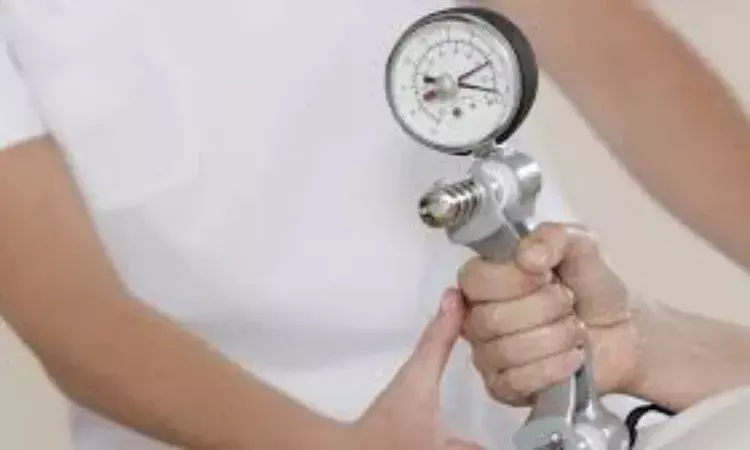- Home
- Medical news & Guidelines
- Anesthesiology
- Cardiology and CTVS
- Critical Care
- Dentistry
- Dermatology
- Diabetes and Endocrinology
- ENT
- Gastroenterology
- Medicine
- Nephrology
- Neurology
- Obstretics-Gynaecology
- Oncology
- Ophthalmology
- Orthopaedics
- Pediatrics-Neonatology
- Psychiatry
- Pulmonology
- Radiology
- Surgery
- Urology
- Laboratory Medicine
- Diet
- Nursing
- Paramedical
- Physiotherapy
- Health news
- Fact Check
- Bone Health Fact Check
- Brain Health Fact Check
- Cancer Related Fact Check
- Child Care Fact Check
- Dental and oral health fact check
- Diabetes and metabolic health fact check
- Diet and Nutrition Fact Check
- Eye and ENT Care Fact Check
- Fitness fact check
- Gut health fact check
- Heart health fact check
- Kidney health fact check
- Medical education fact check
- Men's health fact check
- Respiratory fact check
- Skin and hair care fact check
- Vaccine and Immunization fact check
- Women's health fact check
- AYUSH
- State News
- Andaman and Nicobar Islands
- Andhra Pradesh
- Arunachal Pradesh
- Assam
- Bihar
- Chandigarh
- Chattisgarh
- Dadra and Nagar Haveli
- Daman and Diu
- Delhi
- Goa
- Gujarat
- Haryana
- Himachal Pradesh
- Jammu & Kashmir
- Jharkhand
- Karnataka
- Kerala
- Ladakh
- Lakshadweep
- Madhya Pradesh
- Maharashtra
- Manipur
- Meghalaya
- Mizoram
- Nagaland
- Odisha
- Puducherry
- Punjab
- Rajasthan
- Sikkim
- Tamil Nadu
- Telangana
- Tripura
- Uttar Pradesh
- Uttrakhand
- West Bengal
- Medical Education
- Industry
Lower hand grip strength associated with low visual acuity and other ocular parameters of patient: BMJ

Germany: A new article published in BMJ Ophthalmology showed shorter axial length, visual impairment, lower intraocular pressure, a thinner layer of peripapillary retinal nerve fibers, and a greater prevalence of diabetic retinopathy are all linked to a decreased hand grip strength (HGS).
Previous studies have shown reduced hand grip strength to be related to all-cause mortality, stroke, and cardiovascular and non-cardiovascular mortality, and to ocular parameters of low vision and age-related cataracts. Considering this, Mukharram M. Bikbov and colleagues conducted the study to investigate the relationships between hand grip strength and ocular indices and illnesses.
Participants from the Ural Eye and Medical Study were enrolled in this population-based cohort study for the purpose of data analysis. Out of the 7328 eligible people who were 40 years of age or older, 5899 (80.5%) had systemic and ophthalmological exams, including dynamometric hand grip strength measurement.
The key findings of this study are as follows:
1. Higher HGS correlated with better visual acuity, longer ocular axial length, higher intraocular pressure, thicker peripapillary retinal nerve fiber layer, and lower prevalence of diabetic retinopathy.
2. The presence of nuclear cataract, cortical cataract, subcapsular posterior cataract, open-angle glaucoma, and angle-closure glaucoma were not associated with HGS in the model.
A lower HGS correlated with lower visual acuity, but not with the hearing loss score, the researchers noted, suggesting that vision loss as compared with hearing loss played a more important part in HGS and its associated factors.
In conclusion, a lower HGS is linked to visual impairment, a shorter axial length, a lower intraocular pressure, a thinner layer of nerve fibers in the peripapillary retina, a greater prevalence of diabetic retinopathy, and other factors, including less physical activity, a higher depression score, and worse general health status.
"Measurement of hand grip strength or a handshake may provide the ophthalmologist additional clinical information about the general health and ocular parameters of the patient," the researchers wrote in their study.
Reference:
Bikbov, M. M., Zainullin, R. M., Gilmanshin, T. R., Iakupova, E. M., Kazakbaeva, G. M., Panda-Jonas, S., Tuliakova, A. M., Fakhretdinova, A. A., Gilemzianova, L. I., & Jonas, J. B. (2022). Hand grip strength and ocular associations: the Ural Eye and Medical Study. In British Journal of Ophthalmology (p. bjophthalmol-2022-321404). BMJ. https://doi.org/10.1136/bjo-2022-321404
Neuroscience Masters graduate
Jacinthlyn Sylvia, a Neuroscience Master's graduate from Chennai has worked extensively in deciphering the neurobiology of cognition and motor control in aging. She also has spread-out exposure to Neurosurgery from her Bachelor’s. She is currently involved in active Neuro-Oncology research. She is an upcoming neuroscientist with a fiery passion for writing. Her news cover at Medical Dialogues feature recent discoveries and updates from the healthcare and biomedical research fields. She can be reached at editorial@medicaldialogues.in
Dr Kamal Kant Kohli-MBBS, DTCD- a chest specialist with more than 30 years of practice and a flair for writing clinical articles, Dr Kamal Kant Kohli joined Medical Dialogues as a Chief Editor of Medical News. Besides writing articles, as an editor, he proofreads and verifies all the medical content published on Medical Dialogues including those coming from journals, studies,medical conferences,guidelines etc. Email: drkohli@medicaldialogues.in. Contact no. 011-43720751


